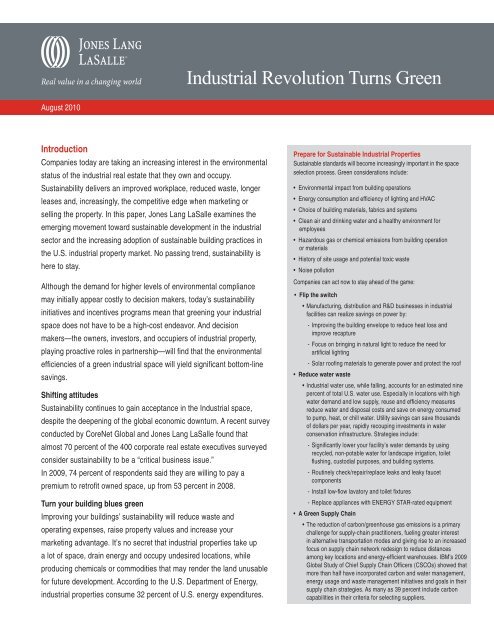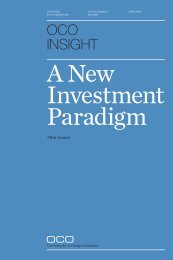PDF: Jones Lang LaSalle: Industrial Revolution Turns Green - Area ...
PDF: Jones Lang LaSalle: Industrial Revolution Turns Green - Area ...
PDF: Jones Lang LaSalle: Industrial Revolution Turns Green - Area ...
- No tags were found...
Create successful ePaper yourself
Turn your PDF publications into a flip-book with our unique Google optimized e-Paper software.
<strong>Industrial</strong> <strong>Revolution</strong> <strong>Turns</strong> <strong>Green</strong>August 2010IntroductionCompanies today are taking an increasing interest in the environmentalstatus of the industrial real estate that they own and occupy.Sustainability delivers an improved workplace, reduced waste, longerleases and, increasingly, the competitive edge when marketing orselling the property. In this paper, <strong>Jones</strong> <strong>Lang</strong> <strong>LaSalle</strong> examines theemerging movement toward sustainable development in the industrialsector and the increasing adoption of sustainable building practices inthe U.S. industrial property market. No passing trend, sustainability ishere to stay.Although the demand for higher levels of environmental compliancemay initially appear costly to decision makers, today’s sustainabilityinitiatives and incentives programs mean that greening your industrialspace does not have to be a high-cost endeavor. And decisionmakers—the owners, investors, and occupiers of industrial property,playing proactive roles in partnership—will fi nd that the environmentaleffi ciencies of a green industrial space will yield signifi cant bottom-linesavings.Shifting attitudesSustainability continues to gain acceptance in the <strong>Industrial</strong> space,despite the deepening of the global economic downturn. A recent surveyconducted by CoreNet Global and <strong>Jones</strong> <strong>Lang</strong> <strong>LaSalle</strong> found thatalmost 70 percent of the 400 corporate real estate executives surveyedconsider sustainability to be a “critical business issue.”In 2009, 74 percent of respondents said they are willing to pay apremium to retrofi t owned space, up from 53 percent in 2008.Turn your building blues greenImproving your buildings’ sustainability will reduce waste andoperating expenses, raise property values and increase yourmarketing advantage. It’s no secret that industrial properties take upa lot of space, drain energy and occupy undesired locations, whileproducing chemicals or commodities that may render the land unusablefor future development. According to the U.S. Department of Energy,industrial properties consume 32 percent of U.S. energy expenditures.Prepare for Sustainable <strong>Industrial</strong> PropertiesSustainable standards will become increasingly important in the spaceselection process. <strong>Green</strong> considerations include:• Environmental impact from building operations• Energy consumption and effi ciency of lighting and HVAC• Choice of building materials, fabrics and systems• Clean air and drinking water and a healthy environment foremployees• Hazardous gas or chemical emissions from building operationor materials• History of site usage and potential toxic waste• Noise pollutionCompanies can act now to stay ahead of the game:• Flip the switch• Manufacturing, distribution and R&D businesses in industrialfacilities can realize savings on power by:- Improving the building envelope to reduce heat loss andimprove recapture- Focus on bringing in natural light to reduce the need forartifi cial lighting- Solar roofi ng materials to generate power and protect the roof• Reduce water waste• <strong>Industrial</strong> water use, while falling, accounts for an estimated ninepercent of total U.S. water use. Especially in locations with highwater demand and low supply, reuse and effi ciency measuresreduce water and disposal costs and save on energy consumedto pump, heat, or chill water. Utility savings can save thousandsof dollars per year, rapidly recouping investments in waterconservation infrastructure. Strategies include:- Signifi cantly lower your facility’s water demands by usingrecycled, non-potable water for landscape irrigation, toiletfl ushing, custodial purposes, and building systems.- Routinely check/repair/replace leaks and leaky faucetcomponents- Install low-fl ow lavatory and toilet fi xtures- Replace appliances with ENERGY STAR-rated equipment• A <strong>Green</strong> Supply Chain• The reduction of carbon/greenhouse gas emissions is a primarychallenge for supply-chain practitioners, fueling greater interestin alternative transportation modes and giving rise to an increasedfocus on supply chain network redesign to reduce distancesamong key locations and energy-effi cient warehouses. IBM’s 2009Global Study of Chief Supply Chain Offi cers (CSCOs) showed thatmore than half have incorporated carbon and water management,energy usage and waste management initiatives and goals in theirsupply chain strategies. As many as 39 percent include carboncapabilities in their criteria for selecting suppliers.
<strong>Industrial</strong> revolution turns green • 2U.S. Energy consumption, by end-useTransportation 29% Residential 21% Commercial 18% <strong>Industrial</strong> 32%ChemicalsHeatingLightingPetroleum refining50%10%40%GasolineDieselJet fuelOtherAir conditioningWater heatingLightingElectronicsRefrigerationDishwshr/laudryOtherAir conditioningHeatingElectronicsVentilationWater heatingRefrigerationOtherPrimary metalsPaperFood processingOther manufacturingNon-manufacturingFeedstocksFuel Source:Primarily petroleumPrimarily natural gasMix: natural gas, coal, nuclear, hydroelectric, renewablesSeveral low or no-cost measures can be implemented quicklyfor immediate gains. Facility operating expenses can instantlybe cut by a cumulative fi ve to 10 percent by adopting simplemeasures such as switching off lights when not in use, adjustingthermostats, turning off computers and offi ce equipment afterhours, and scheduling cleaning crews during daylight hours.Beyond buildings: Cost-effective strategiesToday we need to deploy industrial-strength green strategies thatgo beyond replacing ineffi cient light fi xtures and recycling waste,rethinking every aspect of facilities and operations with an eye onsustainability. Developing a comprehensive, innovative and costeffectivesustainability strategy with a long-term budget forecastdemonstrates the erroneous perception that sustainable buildingsmust cost more. Innovative approaches may include:• Performance contractsRather than spend capital to implement sustainable technologies,self-fund your improvements through performance contracts.Under such contracts, an energy service company or other serviceprovider commits to deliver an annual amount of cost savingson energy and operations when it makes mechanical, electrical,lighting, and building improvements. For the period of the contract—usually fi ve to 10 years—the money saved on operations andenergy can be used to cover the capital costs.• Government incentivesAs industrial properties’ energy expenditures grow, thegovernment is providing more incentives to help stimulate energyeffi ciency projects in industrial facilities. This year, companies fromCaterpillar to Dow Chemical pushed Congress to enact tax creditsfor industrial energy effi ciency projects. Both houses of Congressare currently weighing revisions to tax credits.Many municipalities offer rebates on a case-by-case basis forcommercial and industrial lighting, as well as industrial processupgrades, including premium effi ciency motors, motor controllersand adjustable speed drives, pumps, compressed air systems,refrigeration and dryers. For your state’s incentive policies andprograms, visit www.dsireusa.org.Whirlpool<strong>Jones</strong> <strong>Lang</strong> <strong>LaSalle</strong>’s Atlanta team recently achieved the goal ofLEED® certifi cation for a new, 1.5 million SF regional distributioncenter for Whirlpool in McDonough, GA. Providing projectmanagement and sustainability services, within three years wesuccessfully delivered the project, ahead of schedule and underbudget. The facility exceeded the LEED certifi cation goal, earningGold certifi cation—the largest industrial buildingin the U.S. to qualify for LEED at the Gold level.
<strong>Industrial</strong> revolution turns green • 3McDonald’sThe McDonald’s Corp. continues to lead in improving sustainabilityin its restaurants, corporate buildings and supply chain. <strong>Jones</strong><strong>Lang</strong> <strong>LaSalle</strong> conducted a LEED EB (Existing Buildings) feasibilitystudy that resulted in McDonald’s decision to pursue LEED EBCertifi cation for its 704,120 SF Campus containing offi ce space,food labs and test kitchens. Using Six Sigma methodologies, ourproject team value-engineered an $80,000 budget reduction byrecommending that McDonald’s use in-house employees andresources instead of outside consultants.• Employee educationSome companies are fi nding that involving employees in thesustainability process helps increase savings. Procter & Gamble,which formed one of the fi rst sustainability departments in itsindustry ten years ago, has made strides in greening its productsand facilities. One highly successful initiative was to engageP&G’s 130,000 global employees in the company’s “Take theR (responsibility) for Tomorrow” program. Combining thevolunteer efforts of sustainability site champions with personalizede-training and global websites and communications, P&Gmotivated employees worldwide to behave voluntarily in a moreenvironmentally friendly way. The result: not only are the majorityof P&G personnel enthusiastic about a sustainable workplace, butthey also contribute ideas that save the company about $1 millionper year in energy costs.• Process efficienciesA growing number of companies are fi nding a huge returnon investment by using Six Sigma methodologies to analyzetheir building’s energy processes to address energy effi ciency.Six Sigma is a rigorous method of data and statistical analysisfor measuring and improving a company’s operationalperformance.What you can doHow do you decide which direction for improving sustainability isright for you? Here’s where investors, owners and occupiers canwork together to establish goals, undertake audits and determinewhere savings and improvements can be made.The owner-occupierOwner/users absorb all of the costs of greening their industrialfacilities and, in turn, reap most, if not all, of the savings benefi ts.They can control the improvement process and reduce their utilitybills by conserving energy and water. Lower “down-time” costs(i.e., less energy wasted during non-production hours) are anadded advantage.And the relatively easy steps taken to improve sustainabilitydemonstrate, within the company and in the community, that theowner is investing wisely, in a proactive and visible response tomarket conditions.The landlordAlthough landlords absorb the upfront costs of greening theirfacilities, they achieve a healthy ROI. Energy-effi cient lightingand reduced energy costs accelerate leasing, attract moretenants, and improve tenant retention. Lower operating expensescan justify a higher face rate, ensuring the building’s positionas high-value. Moreover, a federal tax incentive allows ownersto deduct as much as $1.80 per SF for buildings that achieve acertifi ed 50 percent in energy savings.Landlords also stand to gain as their tenant base changes torefl ect the growth in new industries, driven by a wave of capitalincentives for green industry. Many of these new companies aredemanding greener buildings to pursue leaner, more cost-effi cientoperations. <strong>Green</strong>ing enhances a property’s long-term leasingpotential, making it more competitive in the market.
<strong>Industrial</strong> revolution turns green • 4The tenantIn today’s economy, tenants are less interested in bearing thecost of green improvements. A tenant may only occupy anindustrial space for three to fi ve years, and the savings duringthe short time period may not outweigh the initial investment insustainable improvements. Tenants need a strategy that allowsthem to recoup their investment and capitalize on greening theproperty, for example by obtaining roof rights for solar panels,or negotiating the performance of alterations to a building’sheating and lighting systems in common.During lease negotiations, tenants can leverage their potentialtenancy or lease renewal to initiate a green plan and workwith the landlord to install more effi cient lighting fi xtures,HVAC systems, or solar panels. When you are consideringrelocation or a lease renewal is a good time to prepare areasoned approach and initiate the discussion areas, toreduce energy costs.Quartzdyne<strong>Jones</strong> <strong>Lang</strong> <strong>LaSalle</strong> provided tremendous value to industrial tenantQuartzdyne by driving negotiations with the landlord/developerof a new facility. Quartzdyne gained advantages in the land useand construction budgets, LEED analysis and compliance, projectschedule and relocation. Our project management team savedthe client $400,000 by accelerating the rate of construction andreducing acreage. We cut the costs of LEED certifi cation andcommissioning by 50 percent; implemented a planned six-phasemove so as not to interrupt production; and convinced the landlordof the benefi ts of LEED certifi cation to the entire development. Thecompleted project was one of the fi rst industrial LEED NC projectsin the U. S.Additional <strong>Jones</strong> <strong>Lang</strong> <strong>LaSalle</strong> Insights• Lean and Mean Means <strong>Green</strong>• Outsourcing in a strategic future: A study of eight topperforming CRE organizations• President Obama’s plan for energy and the environment• Property sustainability key to economic stimulus• 135 Cost Saving IdeasConclusionThe ongoing shift toward sustainability in the U.S. industrial sector is not a passing trend. Whether driven by a genuine concern forthe environment, a need to meet government regulations, or a desire to achieve cost effi ciencies, green industrial property isthe new way of doing business in real estate. An effective partnership between industrial property building owners and occupiers toimplement sustainable building practices can, and will, make a signifi cant contribution to reducing the nation’s environmental footprint.The results will be considerable cost savings, operational effi ciencies and better workplace.To learn more about our services, please visit us at www.us.joneslanglasalle.com.For more information on <strong>Jones</strong> <strong>Lang</strong> <strong>LaSalle</strong>’s CleanTech practice, energy solutions, or indusrtial real estate services please contact:Ben Stapleton, LEED <strong>Green</strong> AssociateCleanTech Practice Lead, Logistics & <strong>Industrial</strong> Services+1 213 239 6236ben.stapleton@am.jll.comLicense #: 01411478Chris Brandt, LEED APAssociate, Logistics & <strong>Industrial</strong> Services+1 213 239 6234chris.brandt@am.jll.comLicense #: 018217158







